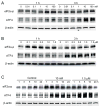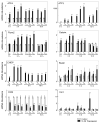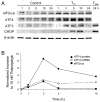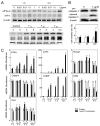Stress to endoplasmic reticulum of mouse osteoblasts induces apoptosis and transcriptional activation for bone remodeling
- PMID: 17418825
- PMCID: PMC1920705
- DOI: 10.1016/j.febslet.2007.03.063
Stress to endoplasmic reticulum of mouse osteoblasts induces apoptosis and transcriptional activation for bone remodeling
Abstract
ATF4 is an essential regulator in osteogenesis as well as in stress responses to the endoplasmic reticulum (ER). We addressed a question: Does ER stress to osteoblasts upregulate ATF4 expression? If so, do they exhibit ATF4-mediated bone remodeling or apoptosis? ER stress, induced by Thapsigargin and tunicamycin, elevated a phosphorylated form of eIF2alpha and ATF4, but the cellular fate depended on treatment duration. The treatment for 1h, for instance, activated Runx2, and type I collagen, while the treatment for 24h induced apoptosis. Our observations suggest that there is a threshold for ER stress and osteoblasts present a bi-phasic pattern of their fate.
Figures






References
-
- Yang X, Matsuda K, Bialek P, Jacquot S, Masuoka HC, Schinke T, Li L, Brancorsini S, Sassone-Corsi P, Townes TM, Hanauer A, Karsenty G. ATF4 is a substrate of RSK2 and essential regulator of osteoblast biology: Implication for Coffin-Lowry Syndrome. Cell. 2004;117:387–398. - PubMed
-
- Wek RC, Jiang HY, Anthony TG. Coping with stress: eIF2 kinases and translational control. Biochem Soc Trans. 2006;34:7–11. - PubMed
Publication types
MeSH terms
Substances
Grants and funding
LinkOut - more resources
Full Text Sources
Other Literature Sources

